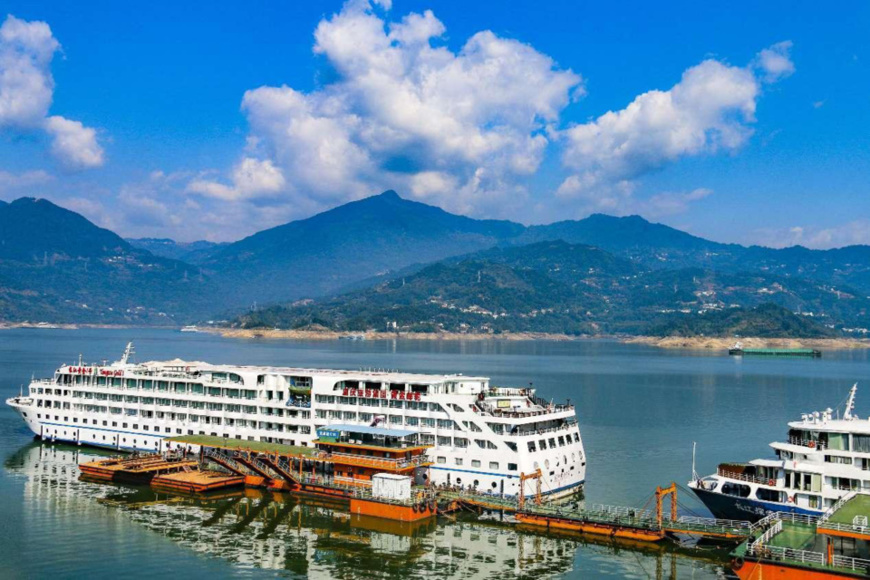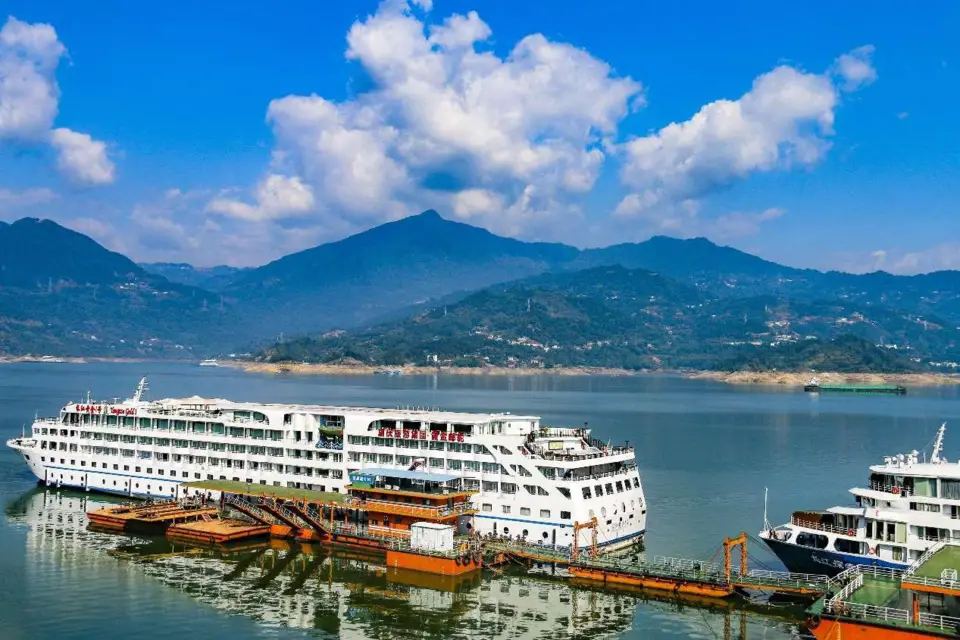By Han Xin, People's Daily

A luxury cruise ship is docked at a port in Zigui county, central China's Hubei province, along the Yangtze River. Its onboard power is supplied by green shore electricity. (Photo by Li Zheng/People's Daily Online)
Focusing on low-carbon and clean energy, China's shipbuilding industry has made significant progress in the development of green vessels this year.
In the first half of the year, Hudong-Zhonghua Shipbuilding (Group) Co., Ltd. delivered a total of nine large liquefied natural gas (LNG) carriers, with new orders exceeding 20 billion yuan ($2.81 billion). Chinese shipbuilding companies now hold a 35 percent market share in the global market of large LNG carriers.
In the field of power batteries, the world's largest pure-electric container ship, with a capacity of 700 TEUs (twenty-foot equivalent units) and built by COSCO Shipping Heavy Industry (Yangzhou) Co., Ltd., has been launched. This pure-electric vessel boasts a range of 380 kilometers.
Henan Diesel Engine Industry Co., Ltd., a subsidiary of China State Shipbuilding Corporation Limited, has successfully ignited a methanol fuel engine it independently developed. The first domestically produced methanol dual-fuel low-speed engine is expected to be launched in 2025.
Different technological pathways are driven by the same philosophy of green development. "Green ships refer to vessels that reduce pollution and greenhouse gas emissions through advanced technologies or the use of clean energy sources," said an official with the Water Transport Bureau of the Ministry of Transport.
According to the official, green ships are environmentally friendly. They produce only a small amount of pollutant or the pollutant they emit can be effectively disposed of. Besides, they are also highly energy-efficient and often incorporate advanced technologies or clean energy sources to enhance their green performance.
As the world's largest shipbuilder, China has been closely following the trend of green and low-carbon development in the shipbuilding industry in recent years. Thanks to the rapid development of new energy and clean energy vessels, the proportion of green vessels has steadily increased.
Currently, about 15.6 percent of newly built ships delivered from China are fueled by new energy and clean energy. Among new orders, this proportion reaches around 50 percent. With the implementation of various emission reduction measures around the world, the two figures are expected to continue expanding.
Why are the shipbuilding industry and the shipping sector turning their attention to green power?
On one hand, green vessels can effectively promote emission reduction in the shipping industry.
"Currently, over 80 percent of global trade is carried out through maritime shipping, and green and low-carbon transition has become an inevitable trend in the development of the shipping industry," said an official with the Maritime Safety Administration of the Ministry of Transport.
In July of this year, the International Maritime Organization adopted a new strategy for reducing greenhouse gas emissions from ships, aiming to achieve net-zero emissions in international shipping sector by around 2050. The use of green alternative fuels is an important pathway to achieve emission reduction.
On the other hand, the green transformation of ships will also effectively promote the upgrading of passenger and cargo vessels.
Green vessels are an important means of transportation for passengers and goods, and their development plays a key role in accelerating the phasing out and upgrading of old ships, promoting the construction of green supporting facilities in ports, and upgrading water transportation infrastructure standards," explained an official with.the Water Transport Bureau, Ministry of Transport.
On Oct. 11, China's first-ever hydrogen fuel cell-powered boat, the Three Gorges Hydrogen Boat 1, completed its maiden voyage in Hubei province. It marked a breakthrough in the application of hydrogen fuel cells in inland waterway. Compared to ships powered by traditional fossil fuel, the use of hydrogen is expected to replace 103.16 tons of fuel every year and reduce carbon dioxide emissions by 343.67 tons.
The energy supply station for the Three Gorges Hydrogen Boat 1 is located at the Yangjiawan Pier downstream of the Three Gorges Project. It is the first inland dock-type hydrogen production and refueling station in China. It utilizes clean electricity generated by the Three Gorges Hydroelectric Power Station to electrolyze water and produce hydrogen. The hydrogen gas is then compressed, stored, dispensed, and supplied to hydrogen-powered vessels.
So far, more than 460 LNG-powered vessels have been operational in China's inland rivers. Shanghai, Jiangsu, and Hubei have introduced relevant policies to encourage the development of electric ships.
The improvement of shore power systems allows more vessels to use green energy. In the first half of this year, the consumption of shore power in Shanghai, Chongqing and 9 provinces along the Yangtze River Economic Belt exceeded 50 million kilowatt-hours.
Since 2021, nearly 13,000 vessels have been retrofitted, with full coverage of shore power connection capabilities achieved for cruise ships, ro-ro cargo vessels, and container ships.
Whether it is promoting the high-quality development of the water transport industry or accelerating the construction of a green transportation system, green and low-carbon transition in the shipping industry has become an inevitable trend.
"As a major maritime shipping nation, China should seize the key window period from 2020 to 2030 to accelerate the breakthrough in core green ship technologies, and strive to become a strong maritime shipping nation, laying a solid foundation for the industrialization of green ships," said an official with the Maritime Safety Administration of the Ministry of Transport.
In the first half of the year, Hudong-Zhonghua Shipbuilding (Group) Co., Ltd. delivered a total of nine large liquefied natural gas (LNG) carriers, with new orders exceeding 20 billion yuan ($2.81 billion). Chinese shipbuilding companies now hold a 35 percent market share in the global market of large LNG carriers.
In the field of power batteries, the world's largest pure-electric container ship, with a capacity of 700 TEUs (twenty-foot equivalent units) and built by COSCO Shipping Heavy Industry (Yangzhou) Co., Ltd., has been launched. This pure-electric vessel boasts a range of 380 kilometers.
Henan Diesel Engine Industry Co., Ltd., a subsidiary of China State Shipbuilding Corporation Limited, has successfully ignited a methanol fuel engine it independently developed. The first domestically produced methanol dual-fuel low-speed engine is expected to be launched in 2025.
Different technological pathways are driven by the same philosophy of green development. "Green ships refer to vessels that reduce pollution and greenhouse gas emissions through advanced technologies or the use of clean energy sources," said an official with the Water Transport Bureau of the Ministry of Transport.
According to the official, green ships are environmentally friendly. They produce only a small amount of pollutant or the pollutant they emit can be effectively disposed of. Besides, they are also highly energy-efficient and often incorporate advanced technologies or clean energy sources to enhance their green performance.
As the world's largest shipbuilder, China has been closely following the trend of green and low-carbon development in the shipbuilding industry in recent years. Thanks to the rapid development of new energy and clean energy vessels, the proportion of green vessels has steadily increased.
Currently, about 15.6 percent of newly built ships delivered from China are fueled by new energy and clean energy. Among new orders, this proportion reaches around 50 percent. With the implementation of various emission reduction measures around the world, the two figures are expected to continue expanding.
Why are the shipbuilding industry and the shipping sector turning their attention to green power?
On one hand, green vessels can effectively promote emission reduction in the shipping industry.
"Currently, over 80 percent of global trade is carried out through maritime shipping, and green and low-carbon transition has become an inevitable trend in the development of the shipping industry," said an official with the Maritime Safety Administration of the Ministry of Transport.
In July of this year, the International Maritime Organization adopted a new strategy for reducing greenhouse gas emissions from ships, aiming to achieve net-zero emissions in international shipping sector by around 2050. The use of green alternative fuels is an important pathway to achieve emission reduction.
On the other hand, the green transformation of ships will also effectively promote the upgrading of passenger and cargo vessels.
Green vessels are an important means of transportation for passengers and goods, and their development plays a key role in accelerating the phasing out and upgrading of old ships, promoting the construction of green supporting facilities in ports, and upgrading water transportation infrastructure standards," explained an official with.the Water Transport Bureau, Ministry of Transport.
On Oct. 11, China's first-ever hydrogen fuel cell-powered boat, the Three Gorges Hydrogen Boat 1, completed its maiden voyage in Hubei province. It marked a breakthrough in the application of hydrogen fuel cells in inland waterway. Compared to ships powered by traditional fossil fuel, the use of hydrogen is expected to replace 103.16 tons of fuel every year and reduce carbon dioxide emissions by 343.67 tons.
The energy supply station for the Three Gorges Hydrogen Boat 1 is located at the Yangjiawan Pier downstream of the Three Gorges Project. It is the first inland dock-type hydrogen production and refueling station in China. It utilizes clean electricity generated by the Three Gorges Hydroelectric Power Station to electrolyze water and produce hydrogen. The hydrogen gas is then compressed, stored, dispensed, and supplied to hydrogen-powered vessels.
So far, more than 460 LNG-powered vessels have been operational in China's inland rivers. Shanghai, Jiangsu, and Hubei have introduced relevant policies to encourage the development of electric ships.
The improvement of shore power systems allows more vessels to use green energy. In the first half of this year, the consumption of shore power in Shanghai, Chongqing and 9 provinces along the Yangtze River Economic Belt exceeded 50 million kilowatt-hours.
Since 2021, nearly 13,000 vessels have been retrofitted, with full coverage of shore power connection capabilities achieved for cruise ships, ro-ro cargo vessels, and container ships.
Whether it is promoting the high-quality development of the water transport industry or accelerating the construction of a green transportation system, green and low-carbon transition in the shipping industry has become an inevitable trend.
"As a major maritime shipping nation, China should seize the key window period from 2020 to 2030 to accelerate the breakthrough in core green ship technologies, and strive to become a strong maritime shipping nation, laying a solid foundation for the industrialization of green ships," said an official with the Maritime Safety Administration of the Ministry of Transport.
 Menu
Menu
 China's shipbuilding industry turns greener
China's shipbuilding industry turns greener
















